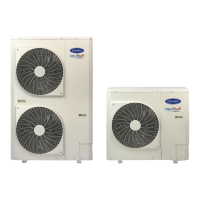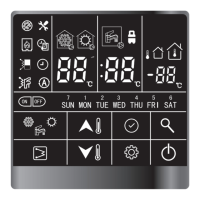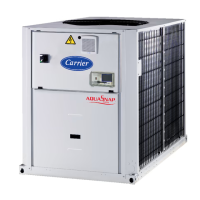Auxiliary accessories connection (Fig. 17)
3-way valve
Frequency Limitation
Stop Unit or Defrosting signals
External temperature probe
The 30AWH units drive a 3-way valve to manage a sanitary
water accumulation tank. The operating logic provides that, in
case of a request for sanitary water by an accumulation tank,
the system controls a 3-way valve to direct the hot water only
to the tank and to operate at the maximum capacity to provide
water at 60 °C (compatible with the operating envelope).
Foroperation,connectthe3-wayvalvebetweenPINS18,N
and10oftheterminalstrip(seeFig.17).PINS18(Line)and
N (Neutral) power the valve (1ph ~ 230V, 2A max), and a
commandsignal(1ph~230V,2Amax)isavailableonPIN10.
Ifusingavalvewithspringreturn,onlyconnectPINS10andN.
The sanitary water request signal must be a Dry Contact type
(contact quality greater than 25mA @ 12V) that closes the
circuitbetweenPINS15and13oftheterminalstrip
(see Fig. 17).
Attention: The sanitary water request has higher priority than
the programmed operating mode in both heating and cooling
mode.
To force the unit to operate at a lower maximum frequency
(to reduce noise) in the absence of a User Comfort Interface,
provide a Dry Contact (contact quality greater than
25mA@12V)betweenPINS13and14oftheterminalstrip
(see Fig. 17). With the contact closed, the unit will operate
with a maximum frequency lower than the standard one,
There are several signals available on the terminal strip to indicate
particular conditions or the stop of the external unit.
The available signals are:
• Defrosting:When operating in Heating mode, depending on
the external environmental conditions, the unit could perform
defrosting cycles to clean the external battery of any ice
formations. Under these conditions, it is not possible to guarantee
the requested temperature output water temperature, which
could reduce general comfort.
(PINS:4-Nor11-N,NUICODE:106or108)
•Alarm:Indicatesanalarmconditionthatstopsthecompressor.
If the positioning of the external unit could induce a non-
representative reading of the external temperature by the
probe positioned on the machine, an additional temperature
otherwise it will operate in standard mode.
Forcorrect operation, it is necessary to congurethe unit
using parameters 5 and 6 from the User Interface menu of
the 33AW-CS1.
The maximum noise reduction is about 3dB at 75% of the
maximum operating frequency of the compressor.
(PINS:5-Nor11-N,NUICODE:147or108)
•AmbientTemperatureReached:Ifsuitablyprogrammedusingthe
User Comfort Interface (NUI), and operating with this interface, a
signal is provided that indicates that the pre-set temperature has
been reached. This signal can be used as the contact window
normallyimplementedinthefan-coils.(PINS:5-N,NUICODE:147)
Several outputs are used for more than one condition. It is possible
toconguretheseoutputsthroughtheUserComfortInterface
installation menu (refer to the 33AW-CS1 manual).
Refer to the tables on page 11 for the correct pin-outs and use of
the signals.
Dehumidier or Humidier
ADehumidieroraHumidiercanbedrivenbyAquasnapPlus
using humidity sensor into 33AW-CS1 interface.
ConnectelectricallyaDehumidieroraHumidiertoN,11
terminalstoarelaythatdrivesDehumidier(NOcontact)or
aHumidier(NCcontact)
CongureNUI code108(2fordehumidier/Humid.)
Configure ambient humidity limit (NUI CODE 107) where
DehumidieroraHumidierisactivated(eg.withcode107=
65,Dehumidierisactivatedwithambienthumidity>UR65%
5% hysteresis)
probe can be provided (NTC 2 wire, 3k @ 25°C, Carrier code:
33AW-RAS01) remote. Connect the terminals of the probe
betweenPINS23and24oftheterminalstrip(seeFig.17).

